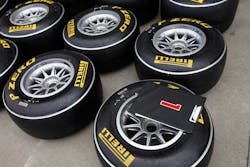Race tires come home for Turkish Grand Prix
The research and development of the tires takes place in Milan, using mathematical modeling and chemical analysis in the laboratory as a starting point. The prototype tires are made in Izmit, and once they have been tested and signed off for production, the definitive race tires can be manufactured.
First, the bead of the tire (the part that contacts with the rim) is made on one production line. There are around 100 separate chemical ingredients in a Formula One tire, split among 18 major components.
Then the belt of the tire is made on a separate production line, which defines the shape of the tire and ensures its overall structural rigidity.
The third production line is the most crucial part of the process, as it is where the bead and the belt are molded together to form a recognizable tire, complete with the tread pattern. At this point the bar code – the tire’s ‘passport’ – is also added.
Next is the vulcanization period during which the tire is ‘cooked’. This determines the definitive characteristics of the compound and structure.
The final step is quality control, which takes in measurements and a scan of the tire similar to an x-ray, in order to verify the integrity and uniformity of the structure. In total, around 50,000 Formula One tires will be made in Izmit this year, located about an hour’s drive from the Istanbul Park circuit.
THE TRACK:
The 5.338-kilometer Istanbul Park Circuit is normally characterized by high asphalt temperatures: but this year the initial forecast is for wet weather until Saturday, when conditions are expected to clear up slightly. This means that Pirelli’s intermediate and wet tires are likely to have a proper run during a race weekend for the first time: and few places are more demanding on tires than Istanbul Park.
There are some areas of heavy deceleration such as the first corner, where the cars change down from seventh to third gear. This can cause a lock-up of the front-left tire due to the unusual camber and lead to flat spotting: a problem that can be reduced or eliminated with an increased grip offered by the soft tire option.
Next up is the most technical section of the track – turns three to six – which consists of a technical sequence of curves where the driver needs to maximize speed by sticking closely to the ideal racing line.
Halfway through the lap there is the legendary Turn Eight, reputed as one of the most technical of the entire World Championship with three apexes and an entry speed of nearly 260kph (162 mph). During this flat-out corner, the cars and tires experience lateral acceleration of 4.6 G as well as vertical load of 950 kilograms (or 2094 pounds). The higher grip of the soft tire improves directional precision and driving safety.
After a short straight the cars reduce speed by 150 mph into a chicane with sharp but opposing corners (turns nine and 10) before another straight where the full power of the engine is unleashed once more, prioritizing traction.
Turn 11 is taken flat-out at 300kph (186 mph), the speed and downforce increasing the turn angle of the tire, which also tends to lift its outside edge.
The final corner calls for precision steering with progressive acceleration in order to avoid wheel-spin, which increases wear, heading back onto the main straight.
“We’re seeing some wet and rainy weather at the moment, which is not what you expect from Turkey,” exclaimed Pirelli’s Motorsport Director, Paul Hembery. “Having said that, we came here to test with Pedro de la Rosa with the Toyota TF109 in April and we found exactly the same sort of conditions: around 15 degrees centigrade (59 degrees Fahrenheit) and rain, so we’ve got some idea of what’s in store. We saw during those tests that the intermediate tire in particular was very impressive and if conditions stay as they are this tire could get some use tomorrow. We’re hoping to have some dry running though as we have brought a new evolution of the hard tire for the teams to test during Friday’s free practice sessions, and it would be interesting to have their feedback. Whatever happens, I’m sure it’s going to be a fascinating weekend.”
PIRELLI'S WET TIRE RANGE
Intermediate
These tires have shallow three-millimeter grooves to disperse water (up to 20 liters of water per second at 300kph – or 186 mph), but this reduces the contact patch and leads to less grip on a dry track. When the rain is heavy, drivers will switch to wet tires at the ‘crossover point’. The markings on the tire are blue.
Wet
These tires have deep five-millimeter grooves in them, similar to a road car tire, and are designed to expel more than 60 liters of water per second at 300kph (186 mph). A road car tire can only displace about 10 liters of water per second, at much lower speeds. The markings on the tire are orange.
